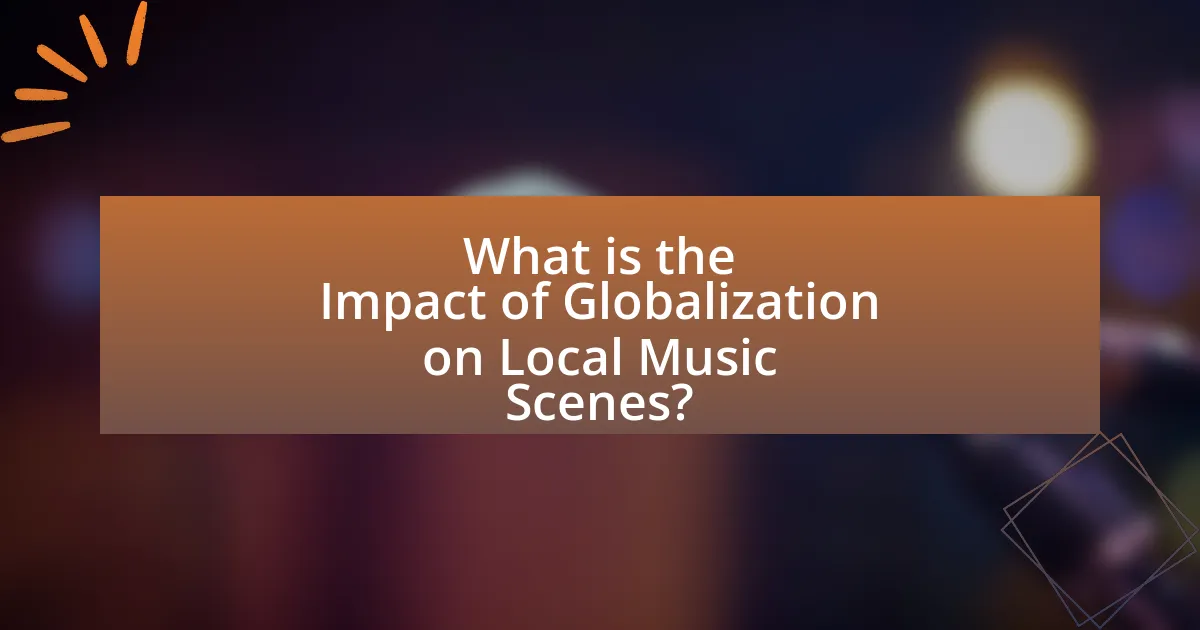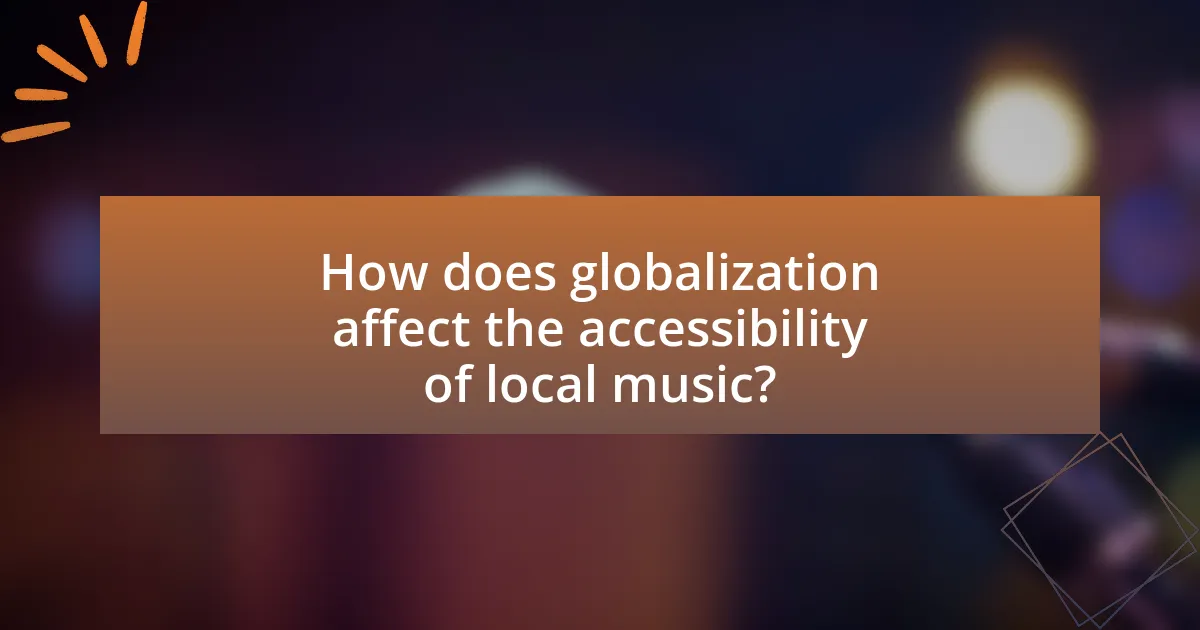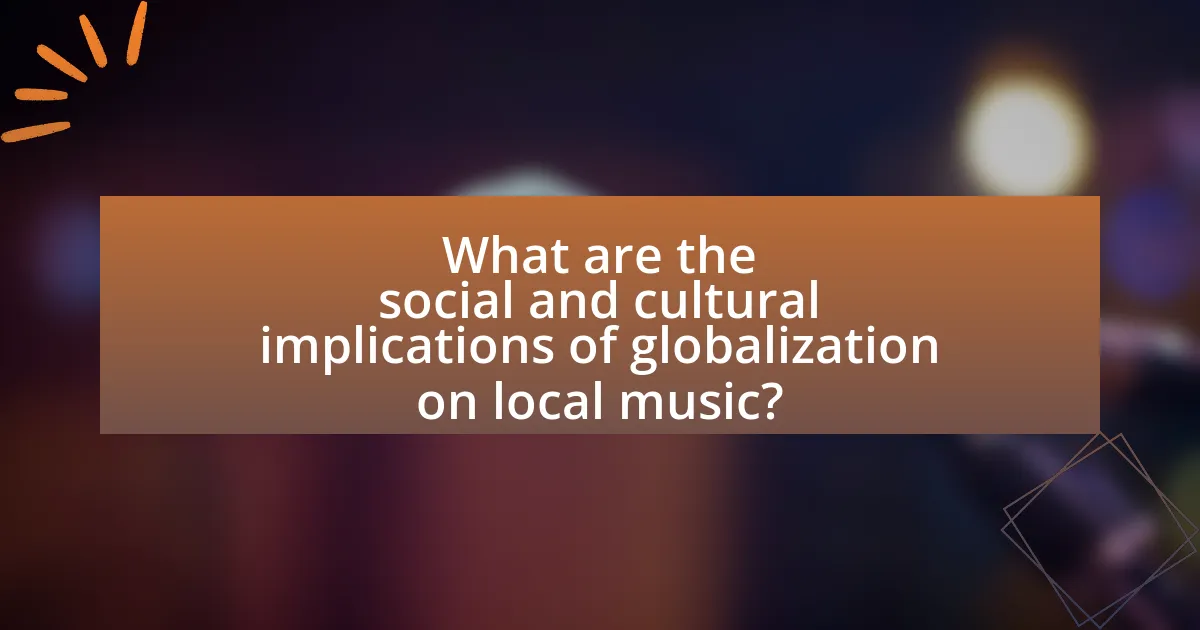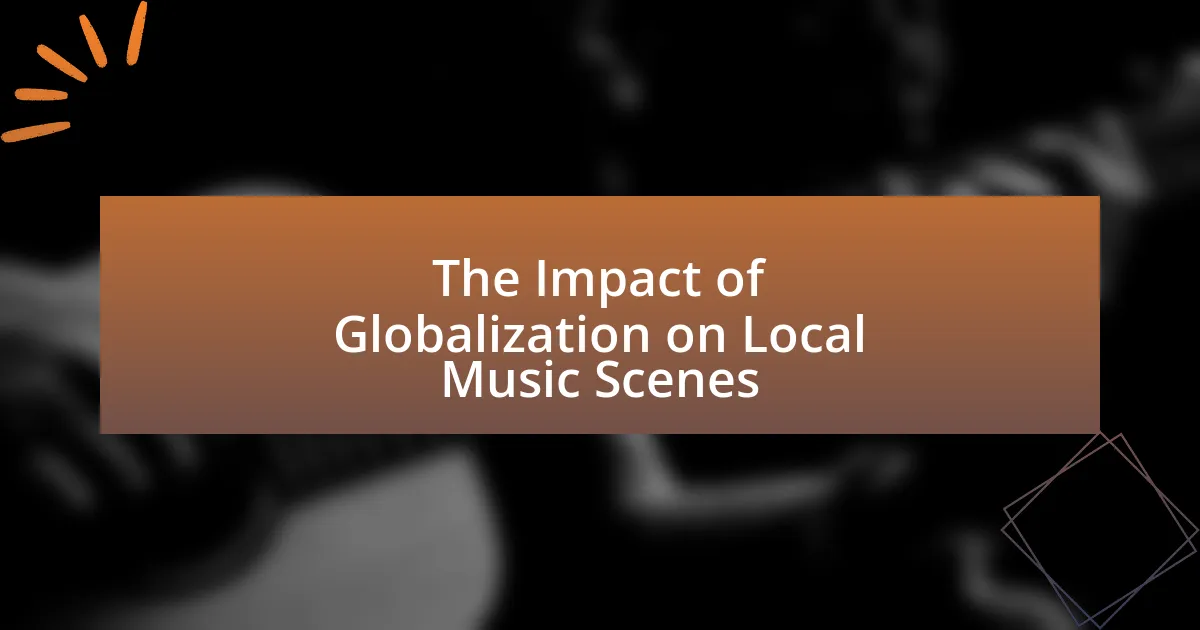The article examines the impact of globalization on local music scenes, highlighting how the exchange of musical styles and cultural practices influences the evolution of local genres. It discusses the hybridization of music, where local sounds merge with global trends, and the role of digital platforms in increasing visibility for local artists. Key factors driving these changes include technological advancements, cultural exchange, and economic influences, while challenges such as commercialization and competition from global acts are also addressed. The article further explores the implications of globalization on community engagement, cultural preservation, and the economic contributions of local music scenes in a globalized context.

What is the Impact of Globalization on Local Music Scenes?
Globalization significantly influences local music scenes by facilitating the exchange of musical styles, genres, and cultural practices across borders. This exchange often leads to the fusion of local sounds with global trends, resulting in new hybrid genres that reflect both local and international influences. For instance, the rise of genres like reggaeton combines Caribbean rhythms with hip-hop and electronic music, showcasing how local artists adapt global influences to create unique sounds. Additionally, globalization can lead to increased visibility for local artists through digital platforms, allowing them to reach wider audiences and gain recognition beyond their immediate geographical areas. However, this can also result in the overshadowing of traditional music forms as global pop culture dominates, potentially leading to a loss of cultural identity. Studies, such as those by the International Federation of the Phonographic Industry, indicate that local music markets are increasingly influenced by global trends, highlighting the dual impact of globalization on both the enrichment and potential dilution of local music scenes.
How does globalization influence the evolution of local music genres?
Globalization influences the evolution of local music genres by facilitating the exchange of musical styles, instruments, and cultural practices across borders. This exchange leads to hybridization, where local music incorporates elements from global genres, resulting in new forms that reflect both local traditions and international influences. For instance, the rise of genres like Reggaeton combines Caribbean rhythms with hip-hop and electronic music, showcasing how local artists adapt global trends to create unique sounds. Additionally, access to digital platforms allows local musicians to reach wider audiences, further blending local and global influences, as seen in the popularity of K-Pop, which integrates Western pop elements while maintaining Korean cultural identity.
What are the key factors driving changes in local music due to globalization?
The key factors driving changes in local music due to globalization include technological advancements, cultural exchange, and economic influences. Technological advancements, such as the internet and digital streaming platforms, enable local artists to access global audiences and collaborate with international musicians, thereby blending diverse musical styles. Cultural exchange occurs as artists and audiences share influences across borders, leading to the incorporation of global genres into local music. Economic influences, including the rise of global music markets, encourage local musicians to adapt their sound to appeal to broader audiences, often resulting in a fusion of traditional and contemporary elements. These factors collectively reshape local music scenes, making them more diverse and interconnected.
How do cultural exchanges shape local music identities?
Cultural exchanges shape local music identities by introducing diverse musical styles, instruments, and practices that influence local artists and genres. For instance, the incorporation of African rhythms into American jazz created a unique fusion that defined the genre. This blending of cultural elements often leads to the emergence of new music forms, as seen in the development of reggae in Jamaica, which was influenced by American rock and rhythm and blues. Additionally, cultural exchanges facilitate collaboration among musicians from different backgrounds, fostering innovation and creativity. The global spread of music through technology and media further accelerates these exchanges, allowing local music scenes to adapt and evolve continuously.
What challenges do local music scenes face in a globalized world?
Local music scenes face significant challenges in a globalized world, primarily due to the overwhelming influence of mainstream, global music trends that can overshadow local talent. This dominance often leads to reduced visibility for local artists, making it difficult for them to gain recognition and support within their own communities. Additionally, the proliferation of digital platforms allows global artists to reach local audiences more easily, further complicating the ability of local musicians to compete. According to a study by the International Federation of the Phonographic Industry, local music accounted for only 30% of total music consumption in many regions, highlighting the struggle for local scenes to thrive amidst global competition.
How does commercialization affect the authenticity of local music?
Commercialization often undermines the authenticity of local music by prioritizing marketability over cultural expression. As local artists adapt their sound and style to appeal to broader audiences and commercial interests, they may dilute traditional elements that define their music. For instance, a study by the University of California found that local genres like folk and traditional music often incorporate pop influences when artists seek commercial success, leading to a loss of original cultural significance. This shift can result in a homogenization of music, where unique local characteristics are replaced by mainstream trends, ultimately affecting the cultural identity of the music scene.
What role do technology and social media play in these challenges?
Technology and social media significantly amplify the challenges faced by local music scenes in the context of globalization. They enable widespread access to global music trends, which can overshadow local artists and genres, leading to a homogenization of musical styles. For instance, platforms like Spotify and YouTube allow users to discover international music easily, often prioritizing popular global hits over local talent. This trend is supported by data indicating that over 60% of music listeners prefer mainstream artists, which diminishes the visibility of local musicians. Additionally, social media can create unrealistic expectations for local artists regarding audience engagement and marketing, as they compete with established global acts that have larger promotional budgets and followings.

How does globalization affect the accessibility of local music?
Globalization increases the accessibility of local music by facilitating the distribution and promotion of diverse musical genres across borders. This phenomenon allows local artists to reach global audiences through digital platforms, such as streaming services and social media, which have expanded since the early 2000s. For instance, platforms like Spotify and YouTube enable listeners worldwide to discover and engage with local music from different cultures, leading to a broader appreciation and consumption of these sounds. Additionally, globalization fosters collaborations between local musicians and international artists, further enhancing visibility and access to local music.
What platforms have emerged for local artists in a global market?
Platforms that have emerged for local artists in a global market include Bandcamp, SoundCloud, and Spotify. Bandcamp allows artists to sell their music directly to fans, fostering a direct connection and enabling local artists to reach a global audience. SoundCloud provides a platform for sharing music and gaining exposure, with features that facilitate interaction between artists and listeners. Spotify, with its extensive user base, offers local artists the opportunity to be featured in playlists, increasing their visibility on a global scale. These platforms have transformed how local artists distribute their music and engage with audiences worldwide, reflecting the impact of globalization on local music scenes.
How do streaming services impact the distribution of local music?
Streaming services significantly enhance the distribution of local music by providing artists with a global platform to reach wider audiences. These platforms, such as Spotify and Apple Music, allow local musicians to upload their tracks easily, bypassing traditional gatekeepers like record labels and radio stations. As a result, local music can gain exposure beyond geographical boundaries, leading to increased streaming numbers and potential revenue. For instance, a report by the International Federation of the Phonographic Industry (IFPI) in 2021 indicated that streaming accounted for 62% of global recorded music revenue, highlighting the importance of these services in promoting diverse music, including local genres.
What are the implications of global music festivals for local artists?
Global music festivals significantly impact local artists by providing exposure, networking opportunities, and potential revenue streams. These festivals often attract large audiences, allowing local artists to showcase their talent to a diverse crowd, which can lead to increased fan bases and future performance opportunities. For instance, the Coachella Valley Music and Arts Festival has featured numerous local artists, resulting in a notable rise in their popularity and bookings post-festival. Additionally, local artists can connect with industry professionals, including agents and producers, which can facilitate career advancement. However, the presence of global acts can overshadow local talent, making it challenging for them to gain recognition. This duality illustrates the complex implications of global music festivals on local music scenes, balancing opportunities with competitive pressures.
How do local music scenes adapt to global influences?
Local music scenes adapt to global influences by incorporating diverse musical styles, technologies, and cultural elements while maintaining their unique identity. For instance, artists often blend traditional local genres with global trends, such as fusing indigenous sounds with hip-hop or electronic music, which can be seen in the rise of genres like reggaeton and K-pop. This adaptation is facilitated by the internet and social media, allowing local musicians to access global audiences and collaborate with international artists. Research indicates that this blending not only enriches local music but also helps preserve cultural heritage by reinterpreting it in contemporary contexts, as evidenced by the success of artists like Anoushka Shankar, who combines classical Indian music with modern influences.
What strategies do local musicians use to maintain cultural relevance?
Local musicians maintain cultural relevance by integrating traditional elements into contemporary music styles. This strategy allows them to connect with both local audiences and global trends, ensuring their music resonates across diverse demographics. For instance, musicians often incorporate indigenous instruments and cultural themes into popular genres, which not only preserves their heritage but also attracts wider attention. Research indicates that local artists who blend traditional sounds with modern influences can increase their visibility and appeal, as seen in the rise of genres like Afrobeat and Reggaeton, which fuse local rhythms with global music trends.
How do collaborations with international artists benefit local scenes?
Collaborations with international artists benefit local scenes by enhancing cultural exchange and increasing visibility for local talent. These partnerships allow local musicians to access new audiences and markets, which can lead to greater opportunities for performance and collaboration. For instance, a study by the International Federation of the Phonographic Industry (IFPI) highlights that local artists who collaborate with international stars often experience a significant boost in streaming numbers and social media engagement, thereby expanding their reach. Additionally, such collaborations can introduce innovative styles and techniques to local artists, fostering creativity and diversity within the local music scene.

What are the social and cultural implications of globalization on local music?
Globalization significantly influences local music by facilitating the exchange of cultural elements, leading to both hybridization and the potential erosion of traditional music forms. This exchange allows local artists to incorporate global styles and genres, enriching their music and expanding their audience reach. However, it can also result in the overshadowing of indigenous music traditions, as global music trends dominate the market and cultural landscape. For instance, the rise of pop music genres worldwide has led to a decline in the popularity of local folk music in various regions, as seen in countries like India, where Bollywood music often eclipses regional styles. This dual impact highlights the complex relationship between globalization and local music, where cultural exchange can both enhance and threaten local identities.
How does globalization affect community engagement in local music?
Globalization enhances community engagement in local music by facilitating cross-cultural exchanges and access to diverse musical influences. This interconnectedness allows local musicians to incorporate global styles and collaborate with artists from different backgrounds, enriching their creative expression. For instance, the rise of digital platforms enables local artists to share their music internationally, attracting a broader audience and fostering local pride. According to a study by the International Federation of the Phonographic Industry, 70% of music consumers engage with music from different cultures, demonstrating the impact of globalization on local music scenes.
What role does local music play in cultural preservation amidst globalization?
Local music plays a crucial role in cultural preservation amidst globalization by serving as a vehicle for expressing and maintaining unique cultural identities. It allows communities to transmit their traditions, values, and histories through musical forms that reflect local experiences and narratives. For instance, studies have shown that traditional music genres, such as folk and indigenous music, often incorporate specific cultural elements that resist homogenization, thereby fostering a sense of belonging and continuity in the face of global influences. Furthermore, local music scenes often create spaces for cultural exchange and dialogue, reinforcing community ties and encouraging the revival of endangered musical practices. This dynamic is evident in various regions where local music festivals and initiatives promote traditional sounds, ensuring their relevance and survival despite the pressures of globalization.
How do local music scenes foster social cohesion in a global context?
Local music scenes foster social cohesion in a global context by creating shared spaces for community engagement and cultural exchange. These scenes provide platforms for diverse groups to come together, facilitating interactions that transcend cultural and geographical boundaries. For instance, local music festivals often attract participants from various backgrounds, promoting inclusivity and mutual understanding. Research indicates that participation in local music events can enhance social networks and community ties, as evidenced by studies showing increased social capital among attendees. This interconnectedness not only strengthens local identities but also contributes to a global dialogue, allowing for the blending of musical styles and cultural practices that enrich both local and global communities.
What are the economic impacts of globalization on local music scenes?
Globalization significantly influences local music scenes by increasing access to diverse musical styles and markets, which can enhance local economies. As international music genres gain popularity, local artists often find new opportunities for collaboration and exposure, leading to increased revenue from performances and merchandise sales. For instance, a study by the International Federation of the Phonographic Industry reported that global music sales reached $23.1 billion in 2020, highlighting the potential for local artists to tap into larger markets. Additionally, globalization can attract tourism, as visitors seek authentic local music experiences, further boosting local economies.
How do local music scenes contribute to local economies in a globalized world?
Local music scenes significantly contribute to local economies in a globalized world by driving tourism, creating jobs, and fostering community engagement. For instance, live music events attract visitors, which boosts spending in local businesses such as hotels, restaurants, and shops. According to a study by the National Endowment for the Arts, music-related tourism generates billions in revenue annually, highlighting the economic impact of local music scenes. Additionally, local musicians and venues create employment opportunities, from performance roles to technical support, further stimulating economic growth. The presence of vibrant music scenes also enhances community identity and cohesion, encouraging local investment and participation in cultural activities.
What funding opportunities exist for local musicians in a global market?
Local musicians can access various funding opportunities in a global market through grants, crowdfunding platforms, and sponsorships. Grants from organizations like the National Endowment for the Arts or local arts councils provide financial support for music projects. Crowdfunding platforms such as Kickstarter and Patreon enable musicians to raise funds directly from fans, allowing them to finance albums or tours. Additionally, sponsorships from brands seeking to connect with music audiences can offer financial backing for events or promotional activities. These funding avenues are essential for local musicians to thrive and compete in an increasingly globalized music industry.
What best practices can local musicians adopt to thrive in a globalized music industry?
Local musicians can thrive in a globalized music industry by leveraging digital platforms for distribution and promotion. Utilizing platforms like Spotify, Apple Music, and social media allows musicians to reach a wider audience beyond their local scene. According to a 2021 report by the International Federation of the Phonographic Industry, digital music revenues accounted for 62% of the global music market, highlighting the importance of online presence. Additionally, collaborating with international artists can enhance visibility and create cross-cultural connections, as seen in successful projects like the collaboration between American rapper Lil Nas X and the country music genre. Engaging with local and global music communities through networking and participation in international music festivals can also provide valuable exposure and opportunities for growth.
How can local artists leverage social media for global reach?
Local artists can leverage social media for global reach by creating engaging content that showcases their unique cultural identity and musical style. By utilizing platforms like Instagram, TikTok, and YouTube, artists can share videos, live performances, and behind-the-scenes content that resonate with diverse audiences worldwide.
For instance, artists can use targeted hashtags and collaborate with influencers to increase visibility, as evidenced by the success of artists like Lil Nas X, who gained global recognition through viral social media campaigns. Additionally, social media analytics tools allow artists to track engagement and adapt their strategies to better connect with international fans, further enhancing their global presence.
What are effective marketing strategies for local music in a global context?
Effective marketing strategies for local music in a global context include leveraging social media platforms, collaborating with international artists, and utilizing streaming services. Social media platforms like Instagram and TikTok allow local musicians to reach global audiences, as evidenced by the viral success of artists like Lil Nas X, who gained fame through TikTok. Collaborating with international artists can enhance visibility and credibility, as seen in the partnerships between local musicians and global stars, which often lead to increased fan engagement. Additionally, streaming services such as Spotify and Apple Music provide local artists with access to global markets, allowing them to distribute their music widely and gain insights into listener demographics. These strategies collectively enable local music to thrive in a globalized environment.
